Acer orporated EMS58 Smart HandHeld User Manual lqZ520 project name QG region date EN
Acer Incorporated Smart HandHeld lqZ520 project name QG region date EN
Contents
- 1. Users Manual S58
- 2. Users Manual S58A
- 3. Users Manual S58a
Users Manual S58a

1
English
Product information
For detailed product information, please go to www.acer.com.
For service and support information, or to download the User
Guide, drivers and applications, please follow the instructions
below:
1. Go to www.acer.com and click Support > DRIVERS AND
MANUALS.
2. Select appropriate items from Group > Series > Products.
3. Select the operating system from the drop-down menu.
© 2015 All Rights Reserved
Acer Liquid Jade Primo Quick Guide
Model: S58A
This revision: 12/2015
Acer Liquid S58A Smartphone
Model number:____________________________________
Serial number: ____________________________________
Date of purchase: _________________________________
Place of purchase: ________________________________
Android is a trademark of Google Inc. Use of this trademark is
subject to Google Permissions.
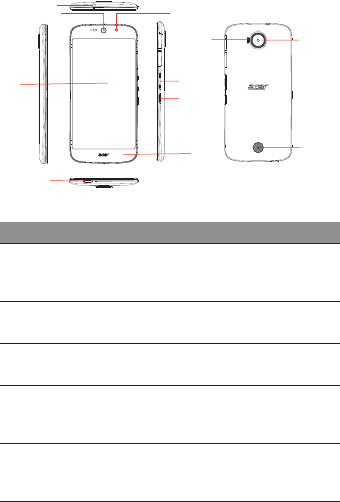
Your smartphone
No. Item Description
1 3.5 mm
headphone
jack
Connects to stereo
headphones.
2 Micro USB
connector
Connects to a USB cable/
charger.
3 Front cameraFront-facing camera suitable for
video chats and self-portraits.
4 Phone
speaker
Emits audio from your
smartphone; suitable for holding
to your ear.
5 Touchscreen Touchscreen to display data,
phone content and enter
information.
1
2
3
4
5
6
7
8
9
10
11

English
6 Handsfree
speaker
Emits audio from your
smartphone; suitable for
handsfree use.
7 Power button Press to turn the screen on/off
or enter sleep mode; press and
hold to turn the smartphone on
or off.
8 Volume up/
down button
Increases or decreases the
phone volume.
9 Flash LED flash for taking photos in
low-light environments.
10 Spaker Internal Spaker.
11 Camera A camera for taking high-
resolution images.
No. Item Description
Note:
For more on how your computer can help you to be more
productive, please refer to the User’s Manual. The User’s
Manual can be downloaded from the Acer support website
by going to: http://go.acer.com/?id=17883

Specifications
Performance
• 1.8 GHz, Hexa-core
•System memory :
• 32 GB
• Android operating system
Display
•5.5" AMOLED LCD,1080 x 1920 resolution
Multimedia
Formats supported:
USB connector
• Type-C USB 3.1 connector
• USB client
• DC power-in (5.35 V, 2 A)
Note
Specifications may vary depending on region and configuration.
Type Formats
Image JPEG, GIF, PNG, BMP
Audio playback MP3, AMR, AAC LC, AAC+, eAAC+, Vorbis, FLAC,
MIDI, WAVE
Ringtone MP3, AMR, AAC LC, AAC+, eAAC+, Vorbis, FLAC,
MIDI, WAVE
Video recording H.263, H.264, MPEG4
Video playback H.263, H.264, MPEG4, VP8
• 3 GB
Connectivity
• Bluetooth 4.1 + LE
• IEEE 802.11b/g/n/a/ac
•US:LTE Band 1900(B2) / 1700(B4) / 2600(B7) / 700MHz(B12)
MHz
•US:WCDMA 850(B5) / 1900(B2) / 1700(B4) / 2100(B1) MHz
• GSM 850 / 900 / 1800 / 1900 MHz
•HSPA / GPRS / EDGE
•GPS

Dimensions
Height 156.52 mm
Width 75.9 mm
Thickness 8.4 mm
Weight 150 g (with battery)
Note
Length of battery operation will depend on power consumption which is
based on system resource use. For example, constantly using the backlight
or using power-demanding apps will shorten battery life between charges.
Camera
•21 MP rear camera
•Auto-focus
• LED flash
•8 MP front camera
• Fixed focus
Expansion
• microSD memory card slot (up to 32 GB)
Battery
•2790 mAh Li-Polymer battery (replaceable)
Dual Flash
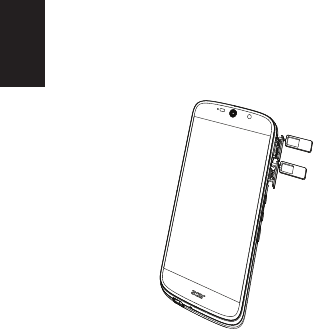
2
English
Setting up for the first time
Inserting the SIM cards and microSD card
1. Remove the SIM / SD card holder from the ritht-hand
side of the phone.
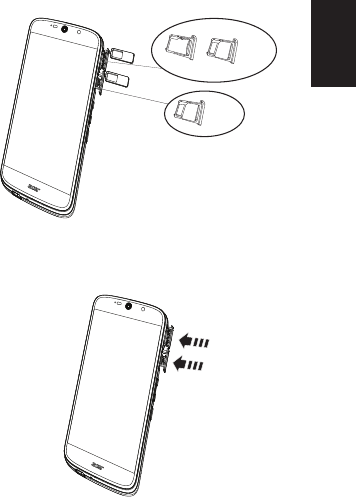
3
English
2. Ensure the microSD card and/or SIMs are fully
seated in the holder and carefully insert the holder
into the slot.
Note: Ensure the cards do not slip out of the holder
when you are reinserting it.
Note: Your smartphone will accept two nano SIM cards (SIM 1 being on
the right) OR a nano SIM and a micro SD card. Specifications vary
depending on model purchased.
Micro SD or SIM2
SIM1
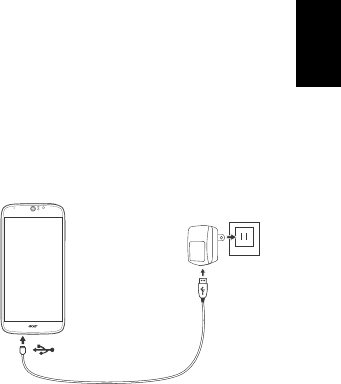
5
English
Charging your phone
For initial use, you need to charge your smartphone for
eight hours. After that you can recharge the battery as
needed.
Connect the AC adapter cord to the micro USB
connector on your smartphone. Plug the AC adapter
into any AC outlet and charge the device.
It is normal for the phone to heat up when charging or
during long periods of use.
All phones are factory tested before release.
Resetting and restarting the phone
Open Settings from the Applications menu, then tap
Backup & reset. Tap Factory data reset and then tap
Reset phone. Tap Erase everything to format your
phone.
If your phone is no longer responding, you can force
the phone to restart by simply removing and replacing
the battery.
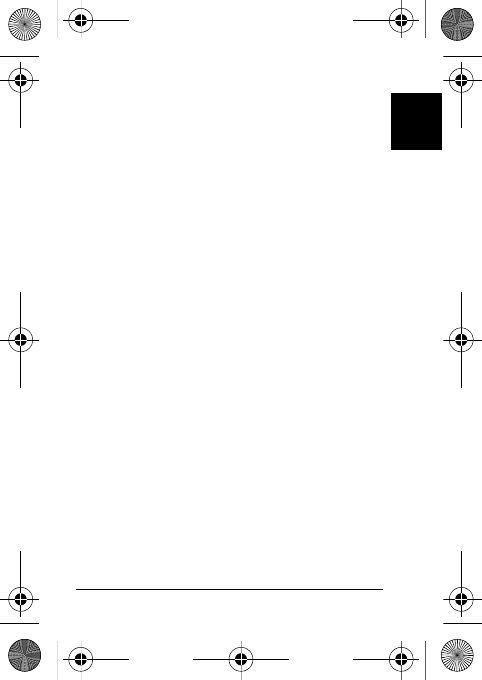
1
English
FCC
Warnings and precautions
• Do not use this product near water.
• Do not place this product on an unstable cart, stand
or table. If the product falls, it could be seriously
damaged.
• Slots and openings are provided for ventilation to
ensure reliable operation of the product and to
protect it from overheating. These openings must
not be blocked or covered. The openings should
never be blocked by placing the product on a bed,
sofa, rug or other similar surface. This product
should never be placed near or over a radiator or
heat register, or in a built-in installation unless
proper ventilation is provided.
• Never push objects of any kind into this product
through cabinet slots as they may touch dangerous
voltage points or short-out parts that could result in a
fire or electric shock. Never spill liquid of any kind
onto or into the product.
• To avoid damage of internal components and to
prevent battery leakage, do not place the product on
a vibrating surface.
• Never use this product when engaging in sporting
activities, exercising, or in any vibrating environment
which may cause a short circuit or damage, and
even a risk of explosion from the battery pack.
CAUTION when listening to music
To protect your hearing, follow these instructions.
• Increase the volume gradually until you can hear
clearly and comfortably.
SL_liJade Primo_PA_EN_v2.book Page 1 Tuesday, December 1,
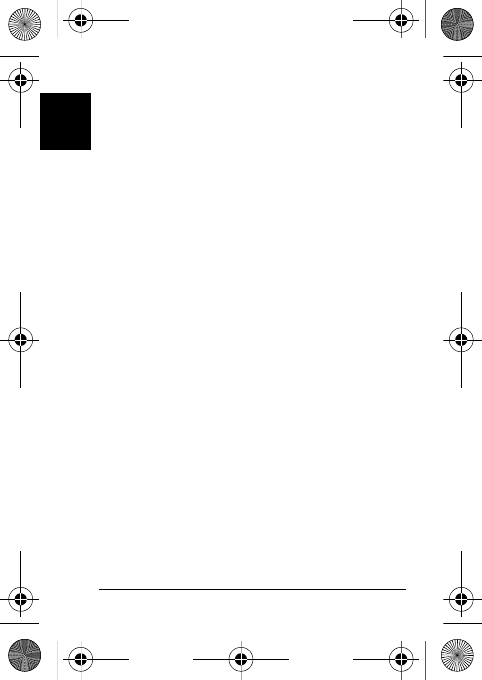
2
English
• Do not increase the volume level after your ears
have adjusted.
• Do not listen to music at high volumes for extended
periods.
• Do not increase the volume to block out noisy
surroundings.
• Decrease the volume if you can’t hear people
speaking near you.
Battery information
This product uses a Lithium Polymer battery. Do not
use it in a humid, wet and/or corrosive environment. Do
not put, store or leave your product in or near a heat
source, in a high temperature location, in strong direct
sunlight, in a microwave oven or in a pressurized
container, and do not expose it to temperatures over
60 °C (140 °F). Failure to follow these guidelines may
cause the battery to leak acid, become hot, explode or
ignite and cause injury and/or damage. Do not pierce,
open or disassemble the battery. If the battery leaks
and you come into contact with the leaked fluids, rinse
thoroughly with water and seek medical attention
immediately. For safety reasons, and to prolong the
lifetime of the battery, charging will not occur at low
(below 0 °C/32 °F) or high (over 45 °C/113 °F)
temperatures.
The full performance of a new battery is achieved only
after two or three complete charge and discharge
cycles. The battery can be charged and discharged
hundreds of times, but it will eventually wear out. When
the talk and standby times are noticeably shorter than
normal, buy a new battery. Use only Acer approved
batteries, and recharge your battery only with Acer
approved chargers designated for this device.
SL_liJade Primo_PA_EN_v2.book Page 2 Tuesday, December 1,
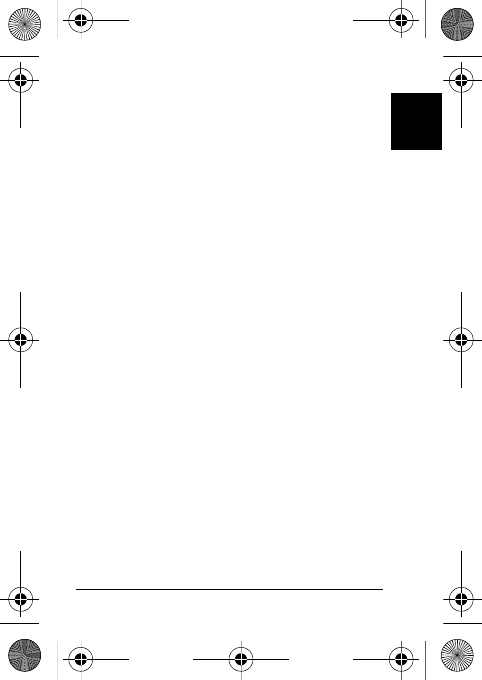
3
English
Unplug the charger from the electrical plug and the
device when not in use. Do not leave a fully charged
battery connected to the ac charger, since
overcharging may shorten its lifetime. If left unused, a
fully charged battery will lose its charge over time. If the
battery is completely discharged, it may take a few
minutes before the charging indicator appears on the
display or before any calls can be made.
Use the battery only for its intended purpose. Never
use any charger or battery that is damaged.
Do not short-circuit the battery. Accidental short-
circuiting can occur when a metallic object such as a
coin, clip, or pen causes direct connection of the
positive (+) and negative (-) terminals of the battery.
(These look like metal strips on the battery.) This might
happen, for example, when you carry a spare battery in
your pocket or purse. Short-circuiting the terminals may
damage the battery or the connecting object.
Leaving the battery in hot or cold places, such as in a
closed car in summer or winter conditions, will reduce
the capacity and lifetime of the battery. Always try to
keep the battery between 15 °C and 25 °C (59 °F and
77 °F). A device with a hot or cold battery may not work
temporarily, even when the battery is fully charged.
Battery performance is particularly limited in
temperatures well below freezing.
Do not dispose of batteries in a fire as they may
explode. Batteries may also explode if damaged.
Dispose of batteries according to local regulations.
Please recycle when possible. Do not dispose as
household waste.
SL_liJade Primo_PA_EN_v2.book Page 3 Tuesday, December 1,
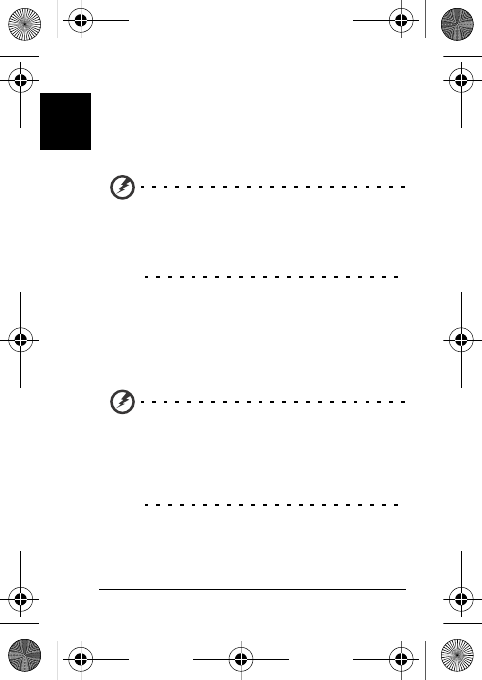
4
English
Replacing the battery pack
Your smartphone uses lithium batteries. Replace the
battery with the same type as that which came bundled
with your product. Use of another battery may present
a risk of fire or explosion.
Warning! Batteries may explode if not handled
properly. Do not disassemble or dispose of
them in fire. Keep them away from children.
Follow local regulations when disposing of
used batteries.
Additional safety information
Your device and its enhancements may contain small
parts. Keep them out of the reach of small children.
Operating environment
Warning! For safety reasons, turn off all
wireless or radio transmitting devices when
using your smartphone device under the
following conditions. These devices may
include, but are not limited to: wireless LAN
(WLAN), Bluetooth and/or 3G.
Remember to follow any special regulations in force in
any area, and always switch off your device when its
use is prohibited or when it may cause interference or
danger. Use the device only in its normal operating
positions. Do not cover the antenna with metal and you
SL_liJade Primo_PA_EN_v2.book Page 4 Tuesday, December 1,
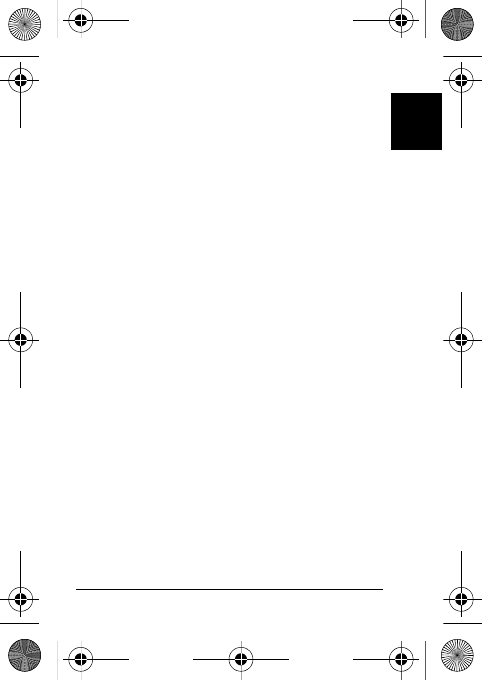
5
English
should position the device at the above-stated distance
from your body. To successfully transmit data files or
messages, this device requires a good quality
connection to the network. In some cases,
transmission of data files or messages may be delayed
until such a connection is available. Ensure that the
above separation distance instructions are followed
until the transmission is completed. Parts of the device
are magnetic.
Metallic materials may be attracted to the device, and
persons with hearing aids should not hold the device to
the ear with the hearing aid. Do not place credit cards
or other magnetic storage media near the device,
because information stored on them may be erased.
Medical devices
Operation of any radio transmitting equipment,
including wireless phones, may interfere with the
functionality of inadequately protected medical devices.
Consult a physician or the manufacturer of the medical
device to determine if they are adequately shielded
from external RF energy or if you have any questions.
Switch off your device in health care facilities when any
regulations posted in these areas instruct you to do so.
Hospitals or health care facilities may be using
equipment that could be sensitive to external RF
transmissions.
Pacemakers. Pacemaker manufacturers recommend
that a minimum separation of 15.3 cm (6") be
maintained between wireless devices and a pacemaker
to avoid potential interference with the pacemaker.
These recommendations are consistent with the
independent research by and recommendations of
SL_liJade Primo_PA_EN_v2.book Page 5 Tuesday, December 1,
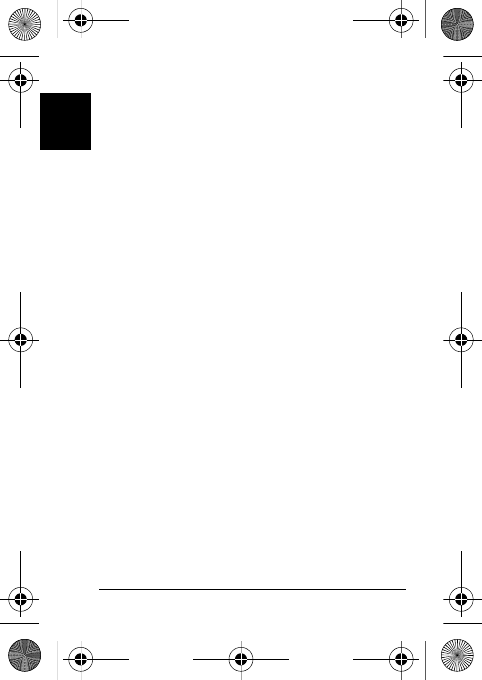
6
English
Wireless Technology Research. Persons with
pacemakers should do the following:
• Always keep the device more than 15.3 cm (6") from
the pacemaker.
• Not carry the device near your pacemaker when the
device is switched on. If you suspect interference,
switch off your device, and move it.
Hearing aids. Some digital wireless devices may
interfere with some hearing aids. If interference occurs,
consult your service provider.
Vehicles
RF signals may affect improperly installed or
inadequately shielded electronic systems in motor
vehicles such as electronic fuel injection systems,
electronic antiskid (antilock) braking systems,
electronic speed control systems, and air bag systems.
For more information, check with the manufacturer, or
its representative. Only qualified personnel should
service the device, or install the device in a vehicle.
Faulty installation or service may be dangerous and
may invalidate any warranty that may apply to the
device. Check regularly that all wireless equipment in
your vehicle is mounted and operating properly. Do not
store or carry flammable liquids, gases, or explosive
materials in the same compartment as the device, its
parts, or enhancements.
For vehicles equipped with an air bag, remember that
air bags inflate with great force. Do not place objects,
including installed or portable wireless equipment in the
area over the air bag or in the air bag deployment area.
If in-vehicle wireless equipment is improperly installed,
and the air bag inflates, serious injury could result.
Using your device while flying in aircraft is prohibited.
SL_liJade Primo_PA_EN_v2.book Page 6 Tuesday, December 1,
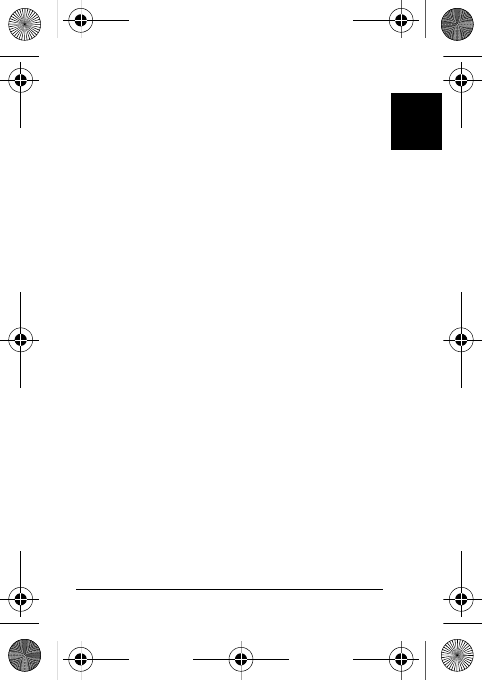
7
English
Switch off your device before boarding an aircraft. The
use of wireless tele-devices in an aircraft may be
dangerous to the operation of the aircraft, disrupt the
wireless telephone network, and may be illegal.
Potentially explosive environments
Switch off your device when in any area with a
potentially explosive atmosphere and obey all signs
and instructions. Potentially explosive atmospheres
include areas where you would normally be advised to
turn off your vehicle engine. Sparks in such areas could
cause an explosion or fire resulting in bodily injury or
even death. Switch off the device at refueling points
such as near gas pumps at service stations. Observe
restrictions on the use of radio equipment in fuel
depots, storage, and distribution areas; chemical
plants; or where blasting operations are in progress.
Areas with a potentially explosive atmospheres are
often, but not always, clearly marked. They include
below deck on boats, chemical transfer or storage
facilities, vehicles using liquefied petroleum gas (such
as propane or butane), and areas where the air
contains chemicals or particles such as grain, dust or
metal powders. Follow any restrictions. Do not use the
device where blasting is in progress.
Emergency calls
Important: Wireless phones, including this device,
operate using radio signals, wireless networks, landline
networks, and user-programmed functions. Because of
this, connections in all conditions cannot be
guaranteed. You should never rely solely on any
wireless device for essential communications like
medical emergencies.
SL_liJade Primo_PA_EN_v2.book Page 7 Tuesday, December 1,
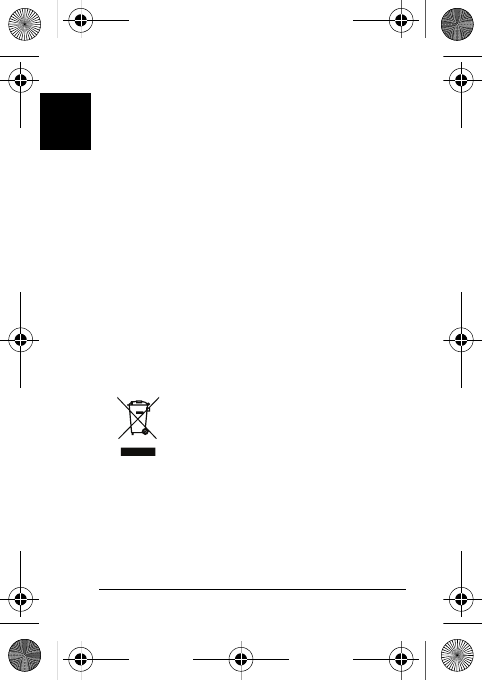
8
English
To make an emergency call:
1. If the device is not on, switch it on. Check for
adequate signal strength. Some networks may
require that a valid SIM card is properly inserted in
the device.
2. Press the End button as many times as needed to
clear the display and ready the device for calls.
3. Enter the official emergency number for your present
location. Emergency numbers vary by location.
4. Press the Call button.
If certain features are in use, you may first need to turn
those features off before you can make an emergency
call. Consult this guide or your service provider for
more information.
When making an emergency call, give all the
necessary information as accurately as possible. Your
wireless device may be the only means of
communication at the scene of an accident. Do not end
the call until given permission to do so.
Disposal and recycling information
Do not throw this electronic device into the
trash when discarding.
To minimize pollution and ensure utmost
protection of the global environment,
please recycle. For more information on the
Waste from Electrical and Electronics
Equipment (WEEE) regulations, visit
http://www.acer-group.com/public/Sustainability/
sustainability01.htm
SL_liJade Primo_PA_EN_v2.book Page 8 Tuesday, December 1,
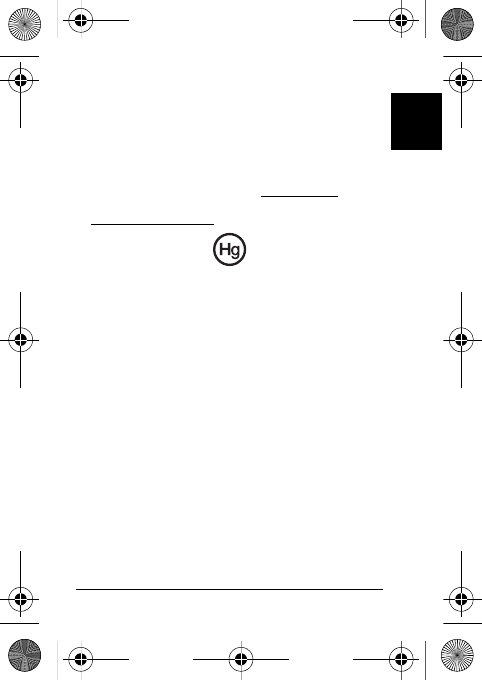
9
English
Mercury advisory
For projectors or electronic products containing an
LCD/CRT monitor or display:
Lamp(s) inside this product contain mercury and must
be recycled or disposed of according to local, state or
federal laws. For more information, contact the
Electronic Industries Alliance at www.eiae.org. For
lamp-specific disposal information, check
www.lamprecycle.org.
Taking care of your smartphone
1. DO take care not to scratch the screen of your
smartphone. Keep the screen clean. When working
with your smartphone, use your finger or fingernail.
Never use an actual pen or pencil or other sharp
object on the screen surface.
2. DO NOT expose your smartphone to rain or
moisture. Do not let water enter the circuitry through
the front panel buttons or expansion slots. In
general, treat your smartphone as you would a
mobile phone or other small electronic device.
3. DO be careful not to drop your smartphone or
subject it to any strong impact. Do not place your
smartphone in your back pocket.
4. DO NOT expose your smartphone to extreme
temperatures. For example, do not leave your
smartphone on the dashboard of a car on a hot day
or when temperatures are below freezing point.
Also, keep it away from heaters and other sources of
heat.
SL_liJade Primo_PA_EN_v2.book Page 9 Tuesday, December 1,
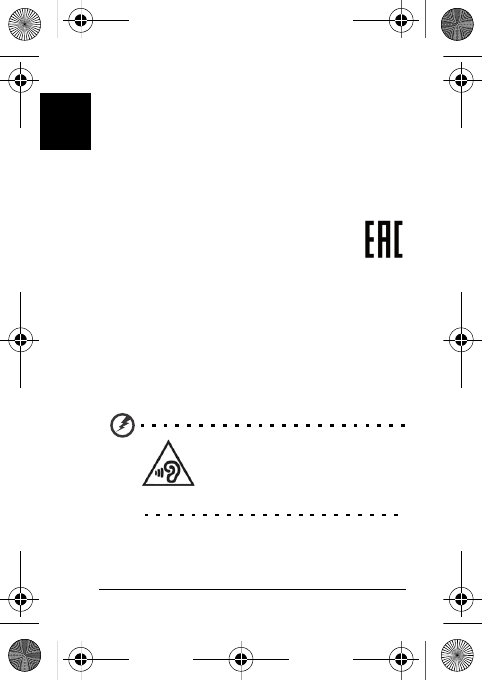
10
English
5. DO NOT use or store your smartphone in any
location that is dusty, damp or wet.
6. DO use a soft, damp cloth to clean your smartphone.
If the surface of the screen becomes soiled, clean it
with a soft cloth moistened with diluted window-
cleaning solution.
7. DO NOT press down on the screen with force,
otherwise you may crack the screen.
Regulatory information
Compliant with Russian regulatory
certification
RoHS compliance
This product is in compliance with Directive 2011/65/EU
of the European Parliament and of the Council of 8 June
2011, on the restriction of the use of certain hazardous
substances (RoHS) in electrical and electronic
equipment and its amendments.
Prevention of hearing loss
Caution: Permanent hearing loss
may occur if earphones or
headphones are used at high
volume for prolonged periods of
time.
SL_liJade Primo_PA_EN_v2.book Page 10 Tuesday, December 1
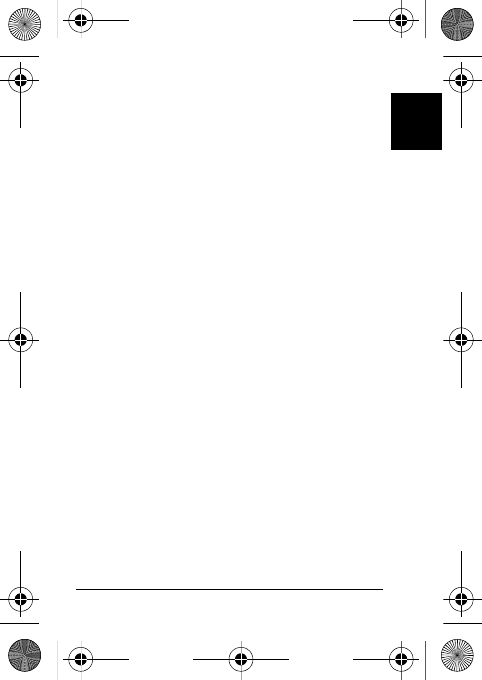
11
English
Wireless operation channels for
different domains
List of National Codes
This equipment may be operated in the following
countries:
N. America 2.412-2.462 GHz Ch01 through Ch11
5.180-5.320 GHz Ch36 through Ch64
5.500-5.700 GHz Ch100 through Ch140
5.745-5.825 GHz Ch149 through Ch165
Japan 2.412-2.484 GHz Ch01 through Ch14
5.180-5.320 GHz Ch36 through Ch64
5.500-5.700 GHz Ch100 through Ch140
Europe ETSI 2.412-2.472 GHz Ch01 through Ch13
5.180-5.320 GHz Ch36 through Ch64
5.500-5.700 GHz Ch100 through Ch140
Country ISO 3166
2 letter code
Country ISO 3166
2 letter code
Austria AT Malta MT
Belgium BE Netherlands NL
Cyprus CY Poland PL
Czech
Republic
CZ Portugal PT
Denmark DK Slovakia SK
Estonia EE Slovenia SI
Finland FI Spain ES
France FR Sweden SE
SL_liJade Primo_PA_EN_v2.book Page 11 Tuesday, December 1
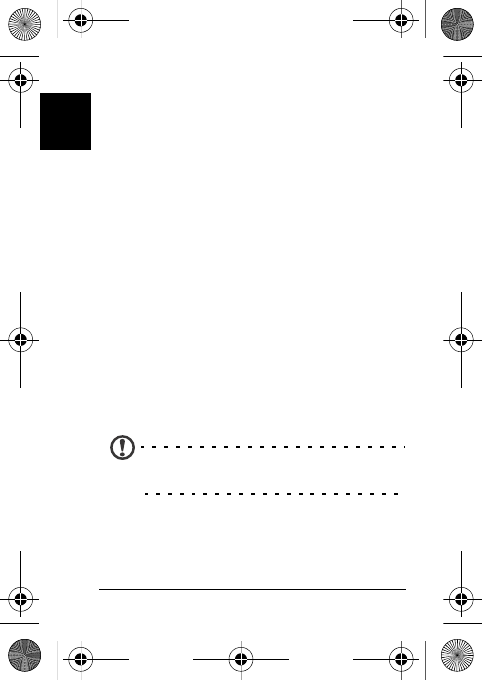
12
English
LCD pixel statement
The LCD unit is produced with high-precision
manufacturing techniques. Nevertheless, some pixels
may occasionally misfire or appear as black or red
dots. This has no effect on the recorded image and
does not constitute a malfunction.
Radio device regulatory notice
Note: Regulatory information below is for models
with wireless LAN and/or Bluetooth only.
General
This product complies with the radio frequency and
safety standards of any country or region in which it
has been approved for wireless use. Depending on
Germany DE United
Kingdom
GB
Greece GR Iceland IS
Hungary HU Liechtenstein LI
Ireland IE Norway NO
Italy IT Switzerland CH
Latvia LV Bulgaria BG
Lithuania LT Romania RO
Luxembourg LU Turkey TR
Country ISO 3166
2 letter code
Country ISO 3166
2 letter code
SL_liJade Primo_PA_EN_v2.book Page 12 Tuesday, December 1
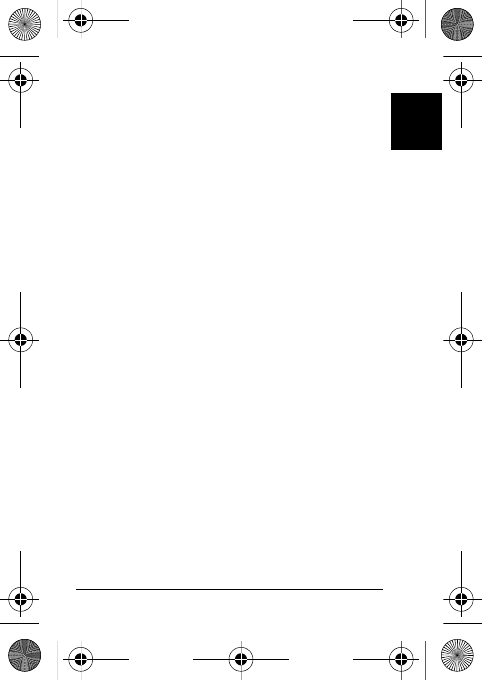
13
English
configuration, this product may or may not contain
wireless radio devices (such as wireless LAN and/or
Bluetooth modules). Information below is for products
with such devices.
FCC regulations
This device complies with part 15 of the FCC Rules.
Operation is subject to the following two conditions: (1)
This device may not cause harmful interference, and
(2) this device must accept any interference received,
including interference that may cause undesired
operation.
This device has been tested and found to comply with
the limits for a Class B digital device, pursuant to Part
15 of the FCC Rules. These limits are designed to
provide reasonable protection against harmful
interference in a residential installation. This equipment
generates, uses and can radiated radio frequency
energy and, if not installed and used in accordance
with the instructions, may cause harmful interference to
radio communications. However, there is no guarantee
that interference will not occur in a particular installation
If this equipment does cause harmful interference to
radio or television reception, which can be determined
by turning the equipment off and on, the user is
encouraged to try to correct the interference by one or
more of the following measures:
• Reorient or relocate the receiving antenna.
• Increase the separation between the equipment and
receiver.
• Connect the equipment into an outlet on a circuit
different from that to which the receiver is
connected.
SL_liJade Primo_PA_EN_v2.book Page 13 Tuesday, December 1
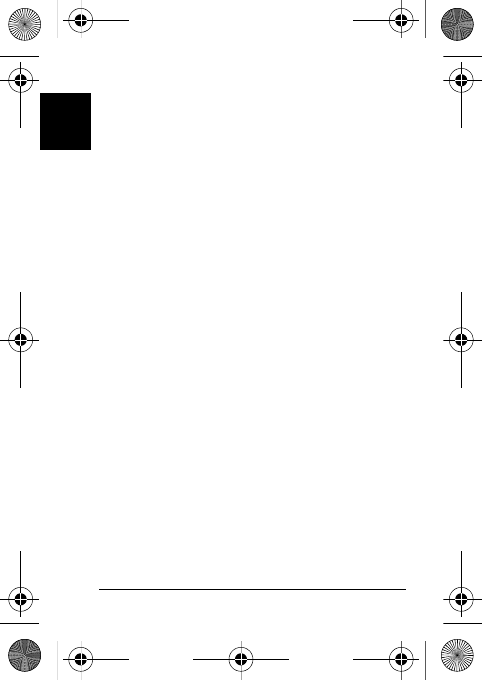
14
English
• Consult the dealer or an experienced radio/TV
technician for help.
Changes or modifications not expressly approved by
the party responsible for compliance could void the
user's authority to operate the equipment.
IC regulations
This device complies with Industry Canada license-
exempt RSS standard(s). Operation is subject to the
following two conditions:
(1) this device may not cause interference, and
(2) this device must accept any interference, including
interference that may cause undesired operation of the
device.
CAN ICES-3(B)/NMB-3(B)
• the device for operation in the band 5150–5250 MHz
is only for indoor use to reduce the potential for
harmful interference to co-channel mobile satellite
systems;
• Users should also be advised that high-power radars
are allocated as primary users (i.e. priority users) of
the bands 5250–5350 MHz and 5650–5850 MHz
and that these radars could cause interference and/
or damage to LE-LAN devices.
RF exposure information (SAR)
This device meets the FCC/IC requirements on the
limitation of exposure of the general public to
electromagnetic fields by way of health protection.
The unit of measurement for the FCC/IC limit is the
"Specific Absorption Rate" (SAR). The SAR limit set by
the FCC/IC is 1.6 W/kg, averaged over 1 g of tissue.
The FCC and IC have granted an Equipment
Authorization for this device with all reported SAR
SL_liJade Primo_PA_EN_v2.book Page 14 Tuesday, December 1
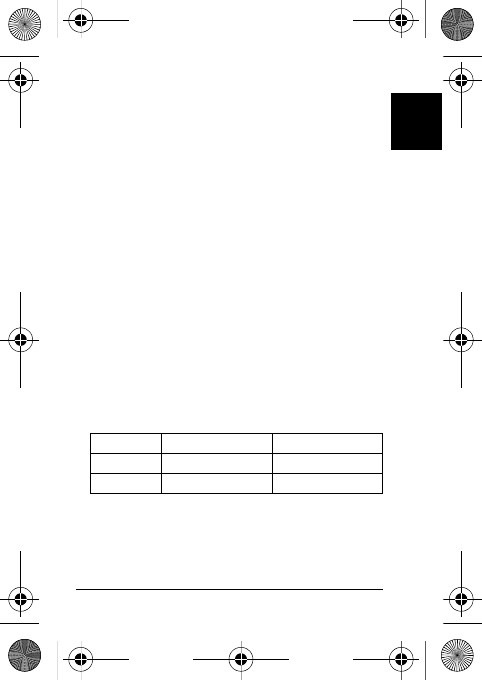
15
English
levels evaluated as in compliance with the FCC and IC
RF exposure guidelines. SAR information on this
device is on file with the FCC and can be found under
the Display Grant section of www.fcc.gov/oet/ea/fccid
after searching on the FCC ID for your device, which
can be found on the product labeling of your device.
For body-worn operation, this device has been tested
use with accessories that contain no metal and that
position the handset a minimum of 1.0 cm from the
body. Use of other accessories may not ensure
compliance with RF exposure. If you do not use a
body-worn accessory and are not holding the device at
the ear, position the handset a minimum of 1.0 cm from
your body when the device is switched on.
During use, the actual SAR level is usually much lower
than the maximum value. In general, the closer you are
to a base station, the lower the transmission output of
your device. To reduce exposure to RF energy, use a
hands-free accessory or other similar option to keep
this device away from your head and body.
This phone meets the FCC and IC requirements on the
limitation of exposure of the general public to
electromagnetic fields by way of health protection.
The highest SAR value of this device is listed below:
FCC (W/kg @1g IC (W/kg @1g)
Head 1.20 1.20
Body 1.18 1.18
SL_liJade Primo_PA_EN_v2.book Page 15 Tuesday, December 1
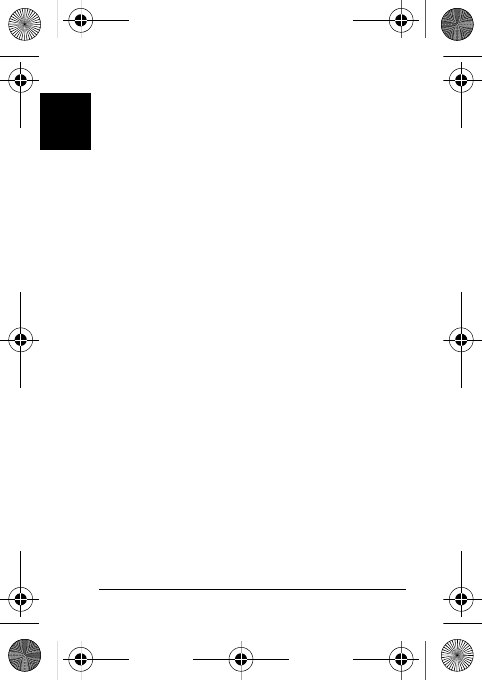
16
English
Hearing Aid Compatibility Information
(HAC)
Your device is compliant with the FCC Hearing Aid
Compatibility (HAC) requirements. The FCC has
adopted HAC rules for digital wireless phones. These
rule require certain phone to be tested and rated under
the American National Standard Institute (ANSI)
C63.19 hearing aid compatibility standards. The ANSI
standard for hearing aid compatibility contains two
types of ratings:
M-Ratings: Rating for less radio frequency interference
to enable acoustic coupling with hearing aids.
T-Ratings: Rating for inductive coupling with hearing
aids in telecoil mode.
Not all phones have been rated, a phone is considered
hearing aid compatible under FCC rules if it is rated M3
or M4 for acoustic coupling and T3 or T4 for inductive
coupling. These ratings are not guarantees. Results
will vary, depending on the level of immunity of your
hearing device and the degree of your hearing loss. If
your hearing device happens to be vulnerable to
interference, you may not be able to use a rated phone
successfully. Trying out the phone with your hearing
device is the best way to evaluate it for your personal
needs.
This phone has been tested and rated for use with
hearing aids for some of the wireless technologies that
it uses. However, there may be some newer wireless
technologies used in this phone that have not been
tested yet for use with hearing aids. It is important to try
the different features of this phone thoroughly and in
different locations, using your hearing aid or cochlear
implant, to determine if you hear any interfering noise.
Consult your service provider or the manufacturer of
SL_liJade Primo_PA_EN_v2.book Page 16 Tuesday, December 1
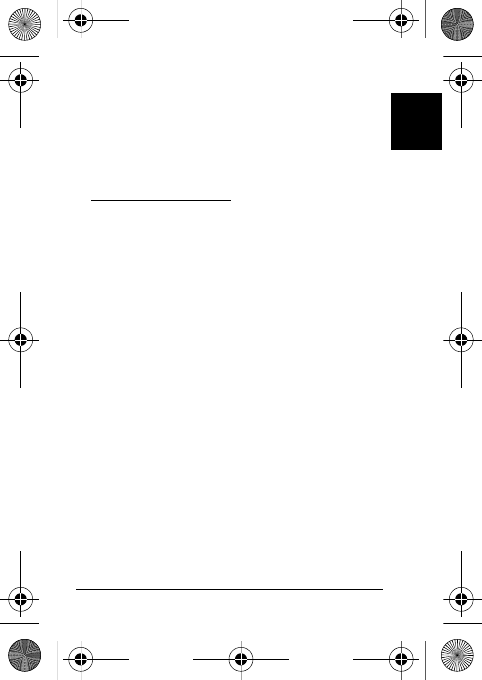
17
English
this phone for information on hearing aid compatibility.
If you have questions about return or exchange
policies, consult your service provider or phone retailer.
Hearing devices may also be rated. Your hearing
device manufacturer or hearing health professional
may help you find this rating. For more information
about FCC Hearing Aid Compatibility, please go to
http://www.fcc.gov/cgb/dro.
Your phone is compliant with FCC HAC regulations
(ANSI C63.19-2011) and rated as M3 and T3 rating or
above.
Turning on Hearing Aid Compatibility
mode
To turn on HAC, open the Applications menu and tap
Settings > Call settings > Advanced settings > Hearing
aids.
SL_liJade Primo_PA_EN_v2.book Page 17 Tuesday, December 1
ICFrench
Avertissementsetmisesengarde
N’utilisezpascetappareilprèsd’unesourced’eau.
Neposezpascetappareilsurunchariot,unsupportouunetableinstable.S’il
tombeparaccident,ilpourraitêtresérieusementendommagé.
Desfentesetouverturessontprévuespourlaventilationafind’assurerun
fonctionnementfiabledel’appareiletdeleprotégerd’uneéventuelle
surchauffe.Cesouverturesnedoiventpasêtreobstruéesoucouvertes.Ces
ouverturesnedoiventjamaisêtrebloquées,parexempleenposantl’appareil
surunlit,uncanapé,untapisoutouteautresurfacesimilaire.Cetappareilne
doitpasêtreposéprèsousurunradiateurouunesourcedechaleur,ouêtre
encastrédansuneinstallation,saufsiuneventilationappropriéeaétéprévue.
N’insérezjamaisdesobjetsdanslesouverturesduboîtierdel’appareil,car
ceux‐cipourraienttoucherdespointsàhautetensionoucréeruncourt‐circuit
etposerunrisqued’incendieoud’électrocution.Nerenversezjamaisdeliquide
surl’appareil.
Pourréduirelerisquededommageinterneetpouréviterquelapilenefuie,ne
posezpasl’appareilsurunendroitsujetàdesvibrations.
N’utilisezjamaiscetappareillorsquevousfaitesdusport,desexercicesoudans
dessituationsoùilrisqueraitdetrembler/d’êtresecoué,cequipourrait
provoqueruncourtcircuitoudesdommagesetmêmeunrisqued’explosionde
lapile.
ATTENTIONlorsquevousécoutezdelamusique
Pourprotégervotreouïe,respectezlesconsignesci‐dessous.
Augmentezlesonprogressivementjusqu’àcequevouspuissiezl’entendre
nettementetconfortablement.
N’augmentezpasleniveauduvolumeunefoisquevosoreillessesontadaptées
auvolumeactuel.
N’écoutezpasunemusiqueàunniveaudevolumeimportantpendantune
longuedurée.
N’augmentezpaslevolumepourmasquerlebruitenvironnant.
Baissezlevolumesivousnepouvezpasentendrelapersonneprèsdevous.
Informationssurlapile
Ceproduitutiliseunepileaulithium‐polymère.Nel’utilisezpasdansdesendroits
humides,mouilléset/oucorrosifs.Neplacezpas,nestockezpasetnelaissezpas
votreproduitdansouàproximitéd’unesourcedechaleur,dansunlieuà
températureélevé,danslalumièredirectedusoleil,dansunfourmicro‐ondesou
dansunconteneurpressurisé,etnel’exposezpasàdestempératuressupérieuresà
60°C(140°F).Lenon‐respectdecesrèglespeutcauserunefuited’acidedelapile,
sasurchauffe,sonexplosionousoninflammationetcauserdesblessureset/oudes
dommages.Nepercezpas,n’ouvrezpasetdémontezpaslapile.Silapilefuitetsi
vousêtesencontactavecdesliquidesdelapile,rincezabondammentavecdel’eau
etconsultezunmédecinimmédiatement.Pourdesraisonsdesécurité,etpour
prolongerl’autonomiedelapile,lachargeneseproduirapasàdestempératures
basses(moinsde0°C/32°F)ouhautes(plusde45°C/113°F).
Lapleineperformanced’unenouvellepileestatteinteseulementaprèsdeuxoutrois
cyclescompletsdechargeetdedécharge.Lapilepeutêtrechargéeetdéchargéedes
centainesdesfois,maiséventuellementelles’usera.Lorsquelesduréesde
conversationetdeveillesontbeaucouppluscourtesqu’àl’habitude,achetezune
nouvellepile.N’utilisezquedespileshomologuéesparAcer,nerechargezvotrepile
qu’avecdesadaptateurshomologuésparAcerpourcetappareil.
Débranchezlechargeurdelapriseélectriqueetdel’appareillorsqu’iln’estpasutilisé.
Nelaissezpasunepilecomplètementchargéeconnectéeàl’adaptateurc.a.,carune
surchargepeutréduiresaduréedevie.Unepile,lorsqu’ellen’estpasutilisée,se
déchargerapetitàpetit.Siunepileestcomplètementdéchargée,l’indicateurde
chargequis’affichesurl’écranpeutprendreplusieursminutesavantd’apparaître,et
aucunappelnepourraêtreeffectuépendantcettepériode.
N’utilisezcettepilequepourlebutàlaquelleelleestdestinée.N’utilisezjamaisde
chargeuroudepilequiseraitendommagé.
Necourt‐circuitezpaslapile.Uncourt‐circuitaccidentelpeutseproduirelorsqu’un
objetmétallique,telqu’unepiècedemonnaie,untromboneouunstylocauseune
connexiondirectedesbornespositive(+)etnégative(‐)delapile.(Cesontdes
bandesdemétalsurlapile.)Cecipeutseproduire,parexemple,lorsquevousavez
unepilederechangedansvotrepocheouvotresac.Lecourt‐circuitdesbornespeut
endommagerlapileoul’objetconnectant.
Lacapacitéetl’autonomiedelapileseraréduitesilapileestlaisséedansunendroit
chaudoufroid,telqu’unevoitureferméeenétéouenhiver.Essayezdetoujours
conserverlapileentre15°Cet25°C(59°Fet77°F).Unappareilavecunepile
chaudeoufroidepeutnepasfonctionnertemporairement,mêmesilapileest

pleinementchargée.Laperformancedelapileestparticulièrementlimitéedansdes
températuresinférieuresà0°C.
Nejetezpaslespilesdansunfeu,carellespeuventexploser.Lespilespeuvent
égalementexplosersiellessontendommagées.Mettezlespilesaurebutenrespect
aveclaréglementationlocale.Sipossible,veuillezlesrecycler.Nelesjetezpasavec
lesdéchetsdomestiques.
Remplacerlapile
Votretéléphoneintelligentutilisedespilesaulithium.Remplacezlapileparunepile
dumêmetypequecellefournieavecvotreappareil.Unepiled’unautretypepeut
poserunrisqued’incendieoud’explosion.
‐‐‐‐‐‐‐‐‐‐‐‐‐‐‐‐‐‐‐‐‐‐‐‐‐‐‐‐‐‐‐‐‐‐‐‐‐‐‐‐‐‐‐‐‐‐‐‐‐‐‐‐‐‐‐‐‐‐‐‐‐‐‐‐‐‐‐‐‐‐‐‐‐‐‐‐‐‐‐‐‐‐‐‐‐‐‐‐‐‐‐‐‐‐‐‐‐‐‐‐‐‐‐‐
Avertissement!Lespilesincorrectementmanipuléesrisquentd’exploser.
Vousnedevezjamaislesdémonter,nilesexposeraufeu.Éloignez‐lesdes
enfants.Respectezlaréglementationlocalepourmettreaurebutlespiles
usagées.
‐‐‐‐‐‐‐‐‐‐‐‐‐‐‐‐‐‐‐‐‐‐‐‐‐‐‐‐‐‐‐‐‐‐‐‐‐‐‐‐‐‐‐‐‐‐‐‐‐‐‐‐‐‐‐‐‐‐‐‐‐‐‐‐‐‐‐‐‐‐‐‐‐‐‐‐‐‐‐‐‐‐‐‐‐‐‐‐‐‐‐‐‐‐‐‐
Consignesdesécuritécomplémentaires
Votreappareilainsiquesesaccessoirespeuventcontenirdepetitespièces.
Gardez‐leshorsdeportéedesjeunesenfants.
Conditionsd’utilisation
‐‐‐‐‐‐‐‐‐‐‐‐‐‐‐‐‐‐‐‐‐‐‐‐‐‐‐‐‐‐‐‐‐‐‐‐‐‐‐‐‐‐‐‐‐‐‐‐‐‐‐‐‐‐‐‐‐‐‐‐‐‐‐‐‐‐‐‐‐‐‐‐‐‐‐‐‐‐‐‐‐‐‐‐‐‐‐‐‐‐‐‐‐‐‐‐‐‐‐‐‐‐‐‐‐
Avertissement!Pourdesraisonsdesécurité,éteigneztouslespériphériques
detransmissionfréquenceradioousans‐fillorsquevousutilisezvotre
téléphoneintelligentdanslesconditionssuivantes.Cespériphériques
peuventinclure,maisnesontpaslimitésà:réseausans‐fil(WLAN),
Bluetoothet/ou3G.
‐‐‐‐‐‐‐‐‐‐‐‐‐‐‐‐‐‐‐‐‐‐‐‐‐‐‐‐‐‐‐‐‐‐‐‐‐‐‐‐‐‐‐‐‐‐‐‐‐‐‐‐‐‐‐‐‐‐‐‐‐‐‐‐‐‐‐‐‐‐‐‐‐‐‐‐‐‐‐‐‐‐‐‐‐‐‐‐‐‐‐‐‐‐‐‐‐‐‐‐‐‐‐‐‐
Rappelez‐vousderespectertouteslesréglementationsenvigueurdansvotrerégion,
etéteigneztoujoursvotreappareilquandsonutilisationestinterditeouquandil
peutcauserdesinterférencesouprésenterundanger.Utilisezl’appareiluniquement
danssespositionsdefonctionnementhabituelles.Cetappareilrépondaux
recommandationsd’expositionRFlorsqu’ilestutilisénormalement,etquandavec
sonantenneilssontpositionnésàaumoins1,5cm(5/8")devotrecorps.Ne
recouvrezpasl’antennedemétaletplacezl’appareilàladistancedevotrecorps
indiquéeci‐dessus.Pourpouvoirtransférerlesfichiersdedonnéesoulesmessages
avecsuccès,cetappareilnécessiteuneconnexionréseaudebonnequalité.Dans
certainscas,letransfertdesfichiersdedonnéesoudesmessagesrisqued’être
bloquéjusqu’àcequ’unebonneconnexionsoitprésente.Assurez‐vousdebien
respecterlesinstructionsdedistancedeséparationjusqu’àcequeletransfertsoit
terminé.Lescomposantsdecetappareilsontmagnétiques.
Lesmatériauxmétalliquespeuventêtreattirésparl’appareiletlespersonnesportant
desprothèsesauditivesnedoiventpastenircetappareilàproximitédeleursoreilles.
Neplacezpasdecartesdecréditouautresmédiasdestockagemagnétiquesà
proximitédel’appareil,carlesdonnéesenregistréesdessusrisquentd’êtreeffacées.
Appareilsmédicaux
L’utilisationdetoutéquipementdetransmissionfréquenceradio,ycomprisles
téléphonessans‐fil,risqued’interféreraveclesfonctionnalitésdesappareils
médicauxinsuffisammentprotégés.Consultezunmédecinouleconstructeurdes
appareilsmédicauxpourdéterminers’ilssontsuffisammentprotégéscontre
l’énergiedefréquenceradioélectriqueexterneousivousavezdesquestions.
Éteignezvotreappareildanslesétablissementsdesoinsmédicauxenrespectant
touteslesréglementationsaffichéesdansceslieuxquivousimposentdelefaire.Les
hôpitauxoulescentresdesoinsmédicauxpeuventutiliserdesappareilspouvant
êtresensiblesauxtransmissionsdefréquenceradioélectriqueexternes.
Lesstimulateurscardiaques.Lesfabricantsdestimulateurscardiaquesconseillentde
respecterunedistancedeséparationminimalede15,3cm(6pouces)entreles
appareilssans‐filetunstimulateurcardiaquepouréviterdeséventuelles
interférencesaveclestimulateurcardiaque.Cesrecommandationssontlefruitde
recherchesetderecommandationsmenéesparl’institutWirelessTechnology
Research.Lespersonnesportantunstimulateurcardiaquedoiventrespecterles
consignesci‐dessous:
Gardeztoujoursl’appareilàunedistanceplusde15,3cm(6pouces)du
stimulateurcardiaque.
Netransportezpasl’appareilprèsdevotrestimulateurcardiaquelorsque
l’appareilestmissoustension.Sivoussoupçonnezuneinterférence,éteignez
votreappareiletdéplacez‐le.
Prothèsesauditives.Certainsappareilssans‐filnumériquespeuventinterféreravec
certainesprothèsesauditives.Sidesinterférencesseproduisent,consultezvotre
fournisseur.
Véhicules
Lessignauxdefréquenceradioélectriquerisquentd’influencerdessystèmes
électroniquesmalinstallésouinsuffisammentprotégésdansdesvéhiculesàmoteur
commelesystèmed’injectionélectronique,lesystèmedefreinageavecantiblocage
électronique,lesystèmeélectroniquedecontrôledelavitesseetlesystèmede
coussingonflable.
Pourdeplusamplesinformations,consultezleconstructeurousonreprésentant.
Seulunpersonneldedépannagequalifiéestautoriséàréparerl’appareilouà
installerl’appareildansunvéhicule.Uneinstallationinappropriéeouundépannage
incorrectpourraitêtredangereuxetrisqued’invaliderlagarantiecouvrantl’appareil.
Vérifiezrégulièrementquetousleséquipementssans‐fildansvotrevéhiculesont
installésetfonctionnentcorrectement.Neconservezpasetnetransportezpasde
produitsàbasedematièresliquidesinflammables,deproduitsàbasedevapeurou
deproduitsexplosifsdanslemêmecompartimentoùvousrangezcetappareil,ses
composantsousesaccessoires.
Encequiconcernelesvéhiculeséquipésdecoussinsgonflables,notezbienqueles
coussinsgonflablessegonflentavecuneforcetrèsimportante.Pourcetteraison,ne
placezaucunobjetetn’installezaucunéquipementsans‐filportablepar‐dessusou
danslerayondefonctionnementdescoussinsgonflables.Siunappareilsans‐filpour
véhiculeestinstalléincorrectementetsilescoussinsgonflablessedéclenchent,de
gravesblessurespeuventseproduire.Ilestinterditd’utiliservotreappareilpendant
levoldansunavion.Éteignezvotreappareilavantl’embarquementdansunavion.
L’utilisationdesappareilssans‐fildansunavionpeutêtredangereusepourle
fonctionnementdel’avion,peutinterrompreleréseaudetéléphonieetpeutêtre
illégale.
Environnementspotentiellementexplosifs
Éteignezvotreappareildanstoutesleszonesprésentantuneatmosphère
potentiellementexplosiveetrespecteztouteslesannoncesetconsignes.Les
atmosphèrespotentiellementexplosivessetrouventdansleszonesoùilest
généralementconseilléd’arrêterlemoteurdevotrevéhicule.Desétincelles
pourraientcréerdesincendiesoudesexplosionsetcauserdesblessuresoumême
entraînerlamort.Éteignezl’appareildanslesendroitsàproximitédespompesà
carburantdanslesstationsessence.Respectezlesrestrictionsconcernantl’utilisation
desappareilsfréquenceradiodanslesdépôts,lesentrepôtsetleszonesde
distributiondecarburant,lesusinesdeproduitschimiquesoudanslesendroitsen
coursd’opérationsdedynamitage.Leszonespotentiellementexplosivessont
normalement,maispastoujours,bienmarquées.Ceszonescomprennentlescales
desbateaux,lesinstallationsfixespourstockageoutransfertdesproduitschimiques,
lesvéhiculesutilisantdesgazdepétroleliquéfiés(commelepropaneoulebutane)
etleszonesdanslesquellesl’aircontientdessubstanceschimiquesoudesparticules
commedesgrains,delapoussièreoudespoudresmétalliques.Respecteztoutesles
restrictions.N’utilisezpasl’appareildansunendroitencoursdedynamitage.
Appelsd’urgence
Important:Lestéléphonessans‐fil,ycompriscetappareil,fonctionnentenutilisant
dessignauxradio,desréseauxsans‐fil,desréseauxcâblésoudesfonctions
programméesparunutilisateur.Decefait,uneconnexiondanstouteslessituations
nepeutpasêtregarantie.Vousnedevezjamaiscomptertropsurunappareilsans‐fil
pourlescommunicationsimportantescommelesurgencesmédicales.
Poureffectuerunappeld’urgence:
5. Sil’appareilestéteint,allumez‐le.Vérifiezquelapuissancedusignalest
adéquate.Certainsréseauxpeuventexigerqu’unecarteSIMsoitprésentedans
l’appareil.
6. AppuyezleboutonFinautantdefoisquenécessairepoureffacerl’écranet
préparerl’appareilpourlesappels.
7. Entrezlenumérod’urgenceofficielpourvotrepositionactuelle.Lesnuméros
d'urgencevarientselonleslieux.
8. AppuyezleboutonAppel.
Sicertainesfonctionssontutilisées,vousdevrezpeutêtreéteindrecesfonctions
avantdepouvoirpasserunappeld’urgence.Consultezceguideouvotreopérateur
pourplusd’informations.
Lorsquevouspassezunappeld’urgence,donneztouteslesinformationsnécessaires,
aussiclairementquepossible.Ilestpossiblequevotreappareil‐sansfilsoitleseul
appareildecommunicationdisponiblesurlesited’unaccident.Neterminezpas
l’appeljusqu’àcequel’onvouslepermette.

Informationsdedéchetetderecyclage
Nejetezpascetappareilélectroniquedanslapoubellelorsquevousvousen
débarrassez.
Pourminimiserlapollutionetassurerlaprotectiondel’environnement,veuillez
recycler.Pourplusd’informationsurlesréglementationssurlesdéchets
d’équipementsélectriquesetélectroniques(DEEE),visitez
http://www.acer‐group.com/public/Sustainability/sustainability01.htm
AvissurleMercure
Pourlesprojecteursouleséquipementsélectroniqueséquipésd’unmoniteurou
affichageACL/cathodique:
Leslampesàl’intérieurdecetéquipementcontiennentdumercureetdoiventêtre
recycléesoudétruitesconformémentauxloislocales,d’étatoufédérales.Pourplus
d’informations,veuillezcontacterl’alliancedesindustriesélectroniquessur
www.eiae.org.Pourdesinformationsdemiseaurebutspécifiquesauxlampes,
visitez
www.lamprecycle.org.
Entretiendevotretéléphoneintelligent
8. FAITESattentionànepasrayerl’écrandevotretéléphoneintelligent.Gardez
toujoursl’écranpropre.Quandvoustravaillezavecvotretéléphoneintelligent,
utilisezvotredoigtouvotreongle.N’utilisezjamaisunstylonormalouun
crayonoutoutautreobjetpointupourtapersurlasurfacedel’écran.
9. N’exposezPASvotretéléphoneintelligentàlapluieouàl’humidité.Nelaissez
pasdel’eauentrerdanslescircuitsvialesboutonsdupanneaufrontal,
connecteursouleslogementsdecarte.Engénéral,traitezvotretéléphone
intelligentcommeuntéléphonecellulaireouunappareilélectroniquefragile.
10. FAITESattentionànepasfairetombervotretéléphoneintelligentoule

soumettreàdeschocsviolents.Negardezpasvotretéléphoneintelligentdans
unepochearrière.
11. N’exposezPASvotretéléphoneintelligentàdestempératuresextrêmes.Par
exemple,nelaissezpasvotretéléphoneintelligentsurletableaudebordd’une
voitureenpleinsoleiloulorsquelatempératureestmoinsdezéro.Faitesaussi
attentionauxchauffagesetsourcesdechaleurs.
12. N’utilisezounegardezPASvotretéléphoneintelligentdansunendroit
poussiéreux,humideoumouillé.
13. FAITESattentionàn’utiliserqu’unchiffondouxetlégèrementmouillépour
nettoyervotretéléphoneintelligent.Silasurfacedel’écranestsale,nettoyez‐la
avecunchiffondouxlégèrementmouilléavecunesolutiondétergentepour
fenêtre.
14. N’appuyezPASsurl’écranavecuneforcebrute,autrementvouspourriezle
casser.
Informationsréglementaires
Conformeàlacertificationréglementairerusse
ConformitéRoHS
CeproduitestconformeàlaDirective2011/65/EUduParlementEuropéenetdu
Conseildu8juin2011,relativeàlalimitationdel’utilisationdecertainessubstances
dangereuses(RoHS)dansleséquipementsélectriquesetélectroniquesetses
amendements.
Prévenirlaperteauditive
Attention:Uneperteauditivepermanentepeutseproduiresides
écouteursoudescasquessontutilisésàunvolumeélevépendantde
longuespériodesdetemps.
Canauxd’opérationsans‐filpourdifférentsdomaines
Canada2,412‐2,462GHzCanal01àCanal11
5,180‐5,320GHz Canal36àCanal64
5,500‐5,700GHzCanal100àCanal140
5,745‐5,825GHzCanal149àCanal165
Japon2,412‐2,484GHzCanal01àCanal14
5,180‐5,320GHzCanal36àCanal64
5,500‐5,700GHzCanal100àCanal140
EuropeETSI2,412‐2,472GHzCanal01àCanal13
5,180‐5,320GHzCanal36àCanal64
5,500‐5,700GHzCanal100àCanal140
Listedecodesnationaux
Cetappareilpeutêtreutilisédanslespayssuivants:
PaysISO3166
Codeà2lettres
PaysISO3166
Codeà2lettres
Autriche
Belgique
Chypre
RépubliqueTchèque
Danemark
Estonie
Finlande
France
Allemagne
Grèce
Hongrie
Irlande
Italie
Lettonie
Lituanie
Luxembourg
AT
BE
CY
CZ
DK
EE
FI
FR
DE
GR
HU
IE
IT
LV
LT
LU
Malte
PaysBas
Pologne
Portugal
Slovaquie
Slovénie
Espagne
Suède
Royaume‐Uni
Islande
Liechtenstein
Norvège
Suisse
Bulgarie
Roumanie
Turquie
MT
NL
PL
PT
SK
SI
ES
SE
GB
IS
LI
NO
CH
BG
RO
TR
DéclarationsurlespixelsACL
L’écranACLdel’appareilestfabriquéavecdesméthodesindustriellesdehaute
précision.Néanmoins,despixelspeuventdetempsentempsdisparaîtreou
apparaîtrecommedespointsnoirsourouge.Cecin’aaucuneffetsurl’image
enregistréeetn’estpasundysfonctionnement.

Déclarationréglementaired’appareilradio
‐‐‐‐‐‐‐‐‐‐‐‐‐‐‐‐‐‐‐‐‐‐‐‐‐‐‐‐‐‐
Remarque:Lesinformationsréglementairessuivantesconcernentuniquement
lesmodèlesavecréseausans‐filet/ouBluetooth.
‐‐‐‐‐‐‐‐‐‐‐‐‐‐‐‐‐‐‐‐‐‐‐‐‐‐‐‐‐‐
Général
Ceproduitestconformeauxstandardsdefréquenceradioetdesécuritédetousles
paysdanslesquelsilaétéapprouvépouruneutilisationsans‐fil.Selonla
configuration,ceproduitpeutounoncontenirdespériphériquesderadiosans‐fil
(p.ex.desmodulesréseausans‐filet/ouBluetooth).Lesinformationsci‐dessoussont
pourlesproduitsavecdetelspériphériques.
RèglementsIC
CetappareilestconformeauxnormesCNRexemptesdelicenced’IndustrieCanada.
Lefonctionnementestsubordonnéauxdeuxconditionssuivantes:
(1) cetappareilnedoitpasprovoquerd’interférences,et
(2) cetappareildoitacceptertouteinterférence,ycomprisdesinterférencesqui
peuventprovoquerunfonctionnementnondésirédel’appareil.
CANICES‐3(B)/NMB‐3(B)
•l’appareilpourunfonctionnementdanslabande5150à5250MHzestréservéà
uneutilisationenintérieurafinderéduirelesrisquesd’interférencesnuisiblesavec
lessystèmessatellitesmobilesutilisantlesmêmescanaux;
•Lesutilisateursdoiventêtreinformésquelesradarsàhautepuissancesont
désignéscommeutilisateursprincipaux(ilsontlapriorité)desbandes5250à5350
MHzet5650à5850MHzetcesradarspourraientcausedesinterférenceset/ou
endommager les appareils de réseaux locaux exempts de licence (LELAN).

Informationssurl’expositionàlaradiofréquence(DAS)
Cetappareilestconformeauxexigencesd’ICsurlalimitationd’expositiondupublic
généralauxchampsélectromagnétiquespourprotégerlasanté.
L’unitédemesuredelalimiterecommandéeparICestle«débitd’absorption
spécifique»(DAS).LalimiteDASdéfinieparICest1,6W/kg,surunemoyennede1g
depeau.ICaaccordéuneautorisationd’équipementpourcemodèled’appareilavec
touslesniveauxdeDASindiquéscommerespectantlesrecommandations
d’expositionRFd’IC.
Pourl’utilisationsurlecorps,cetappareilaététestépouruneutilisationavecdes
accessoiresnecontenantaucunmétaletquipositionnentl’appareilauminimumà
1,0cmducorps.L’utilisationd’autresaccessoirespeutnepasassurerlaconformitéà
l’expositionàlaradiofréquence.Sivousn’utilisezpasunaccessoireportésurlecorps
etnetenezpasl’appareilàl’oreille,positionnezl’appareilauminimumà1,0cmdu
corpslorsqueletéléphoneestallumé.
Pendantl’utilisation,leniveauDASestbieninférieuràlavaleurmaximale.Engénéral,
plusvousêtesprochedelastationdebase,pluslasortiedetransmissiondevotre
appareilestfaible.Pourréduirel’expositionàl’énergiederadiofréquence,utilisezun
accessoiremainslibresouuneautreoptionsimilairepouréloignercetappareilde
votretêteetdevotrecorps.
Cetéléphoneestconformeauxexigencesd’ICsurlalimitationd’expositiondupublic
généralauxchampsélectromagnétiquespourprotégerlasanté.
LavaleurDASlaplusélevéedecetappareilestlistéeci‐dessous:
IC(W/kgà1g)
Tête 1.20
Corps 1.18
Activerlemodedecompatibilitéàuneprothèseauditive
Pouractiverlacompatibilitéàuneprothèseauditive,ouvrezlemenuApplicationset
appuyezsurParamètres>Paramètresd’appel>Paramètresavancés>Prothèses
auditives.